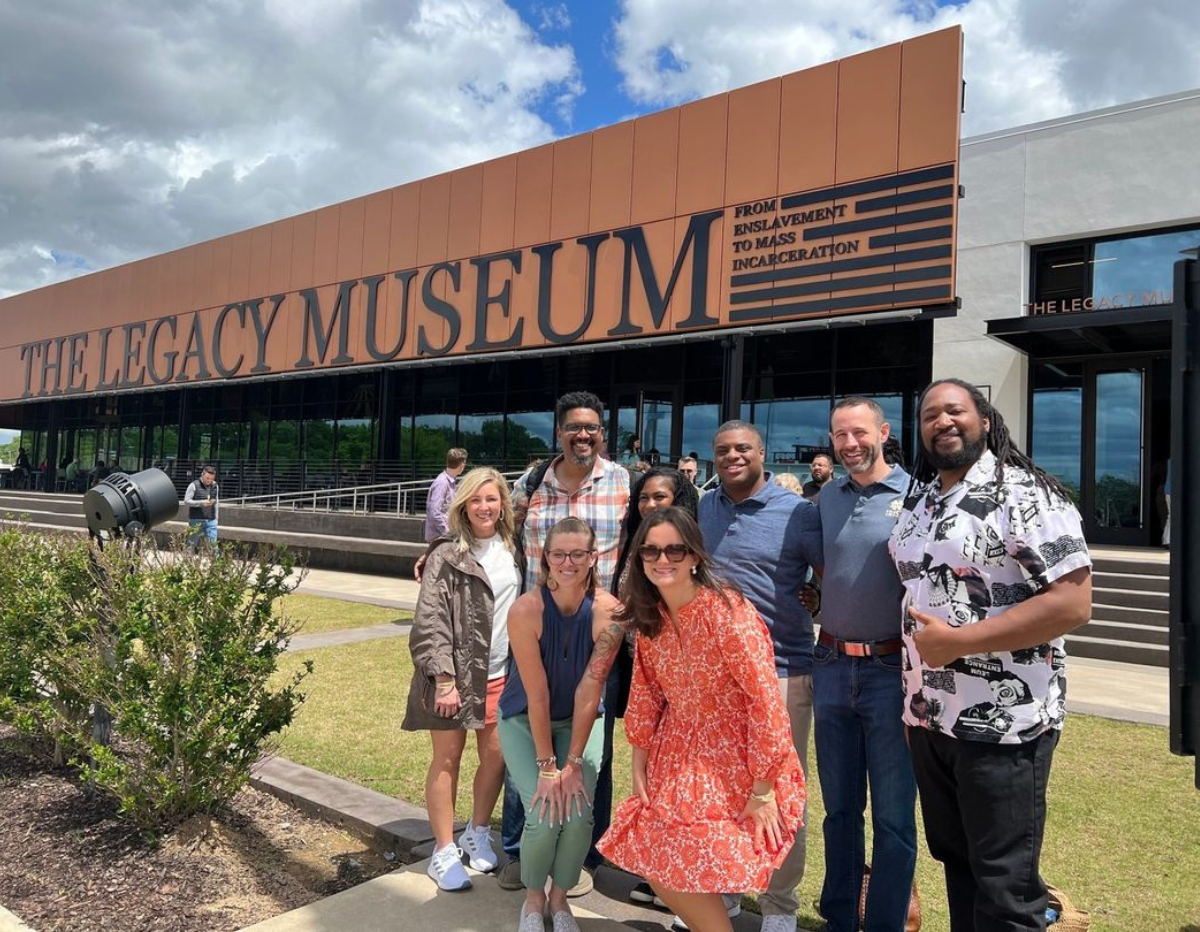
EJUSA staff members and partners traveled to Montgomery, Alabama to visit Equal Justice Initiative’s Legacy Museum and National Memorial for Peace and Justice. The tour group included partners from our Evangelical Network and Conservatives Concerned About the Death Penalty. Here are reflections from our staff.
Demetrius Minor, Manager, Conservatives Concerned About the Death Penalty
We are not too far removed from history. That could’ve easily been me, one of the statistics in that memorial. Especially because I grew up in one of the counties that had lynchings. I read about one instance of a Black teenager hanging around a white person, and as I read that, I was standing next to a white person in our delegation. The very thing I was doing in that moment could have made me part of that number of lynchings. It was a painful reminder that if we don’t know where we’ve been, we can’t get to where we’re going.
Libbie Love, Programs Administrative Manager
I remember quite vividly that I was in the elevator with someone from our conservative group. He had just spoken to his daughter, trying to explain all about the museum. But he said he was just going to have to bring both his daughters. Combined with the other conversations we’d been having, his intention presages hope for a country still mired in racial injustices. It bodes well for the future. Here’s someone who’s bringing his family, another generation to learn about something they might not get to read about in school. I have so much hope for what will come out of that.
Nicholas Cote, Western Regional Organizer, Conservatives Concerned About the Death Penalty
I’ve never been so struck walking into a museum. The first room is this violent baptismal wave that confronts you. A video screen showing this wave takes up an entire wall. That word “baptismal” struck me right away. It felt like this was about the sins of our country and an opportunity to first acknowledge them before we can do anything else. I want to go back. It’s an incredibly emotional and thought-provoking confrontation with the past that links the history to what’s going on now. It forces you to think about why these connections exist. It’s called a legacy museum for a reason…It feels like a fire has been lit, and I want to see where it goes.
Sam Heath, Manager, Evangelical Network
There seemed to be a general agreement from the attendees about the overall read of history that EJI gave, namely, that our country and its systems have at its core a stain of white supremacy, that the original sin of our country is not slavery but white supremacy. People there really resonated with the idea that our criminal legal system is functioning as intended and cannot bring healing and hope, that we as a nation must turn to a wholly other way of doing safety if we want healing to be possible. Many especially appreciated hearing that restorative justice offers a measure of healing to its participants. Everyone left with an overwhelming sense that the history many of us were presented in school was not only one-sided but false. Many had to reconcile with this reality and then wrestle with how to live in light of this.
Jiva Manske, Director of National Organizing and Narrative Shifting
The Legacy Museum is a beautiful, heartbreaking, and sacred place that weaves a powerful and clear narrative: the institution of slavery is not gone, it has only evolved. The experience of the museum is a catharsis. Big, cathartic experience can open people’s hearts and minds, and it did on this trip. People who thought the criminal legal system needs reforms walked shared that now they understand that the whole thing needs to be transformed, or even razed to the ground. People who previously thought contemporary struggles for racial justice were misguided said now they want to join those struggles. A big, cathartic experience is not enough to change people’s perspectives. The process of healing collective trauma mirrors the process of healing individual trauma, and vice versa. Both take deep accompaniment rooted in positive social engagement. While this experience was certainly a benchmark for us, the change that happened for people is neither big nor sustainable, without significant follow up. I left with more certainty that the next phase of work needs to be even more rooted in racial justice, including understanding history and legacy, historical trauma, explicitly racist laws still on the books today, and institutions and impact today.
Will Simpson, Director of Violence Reduction Initiatives
The journey to Montgomery proved to be deeply impactful on a personal level, while also shedding light on the potential for growth within our evangelical and conservative networks. The museum effectively conveyed the evolution of white supremacy in our nation, from the abduction, enslavement, and torture of millions of African people to the current systemic violence present in our criminal legal system. Rarely has a space so vividly illustrated this narrative, touching on all senses and eliciting a range of emotions. Establishing a baseline understanding of white supremacy and state violence is crucial for our networks to expand their work on community safety. Overall, the trip to Montgomery was essential in setting the stage for our networks to better comprehend the consequences of white supremacy and state violence, and to work towards bridging the gap between the death penalty and community safety. With ongoing dialogue and collaboration, both networks can contribute to working to build a world where we reimagine true safety and build the systems that sustain it.


